Posted in Blog, Entrepreneurship, Grow by Jo North
Empowerment through Intentional Goal Setting
Intentional goal setting is empowering. It means setting goals that are truly meaningful to you, goals that play to your unique strengths, passion, purpose, and individuality.
Setting goals with intention also helps you to achieve more by doing less, and overcome obstacles along the way.
In this article, I’ll explain WHY it’s so important and empowering to intentionally set goals that are meaningful to you, and HOW to set intentional goals, with a simple goal-setting process.
I’ll also address why it’s so easy to set goals that we think we “should” go for, and what you can do to avoid that happening.
The guidance and steps in this article are appropriate for setting professional, career, team and business-wide goals.
What does Being Intentional Mean?
Being intentional means thinking about your work and your life in way that’s committed, purposeful, and deliberate. It increases your focus on what’s most important to you.
The key steps to being intentional are:
- Be deliberate
- Know the result you want
- Focus your energy and attention
- Use your time purposefully
- Be mindful of your most meaningful relationships
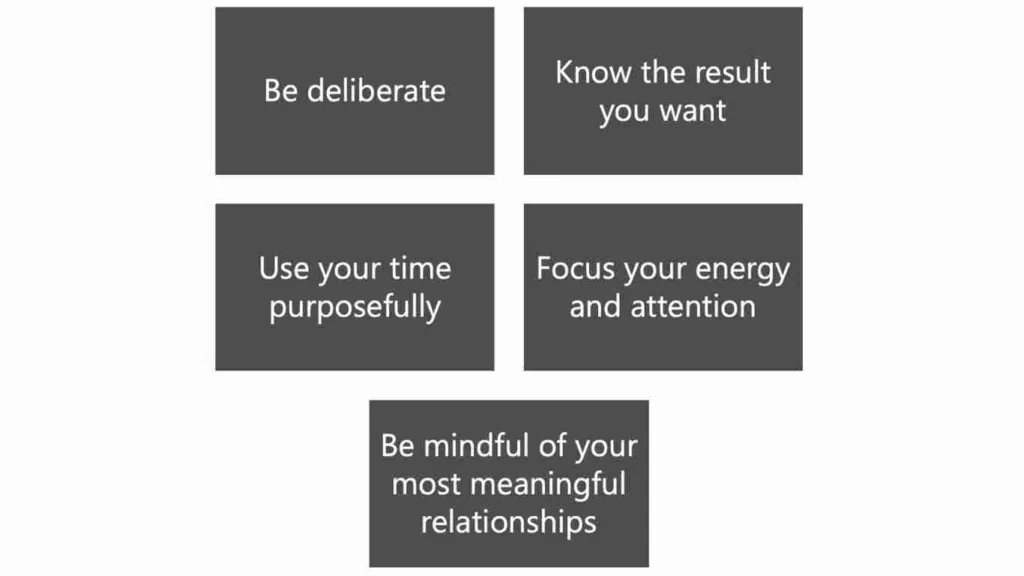
Types of Goals
There are two types of goals:
- Performance goals
- Mastery goals
Performance goals and mastery goals are two types of goals that individuals and organizations can set. While both types of goals can help to improve performance, they differ in their focus and approach.
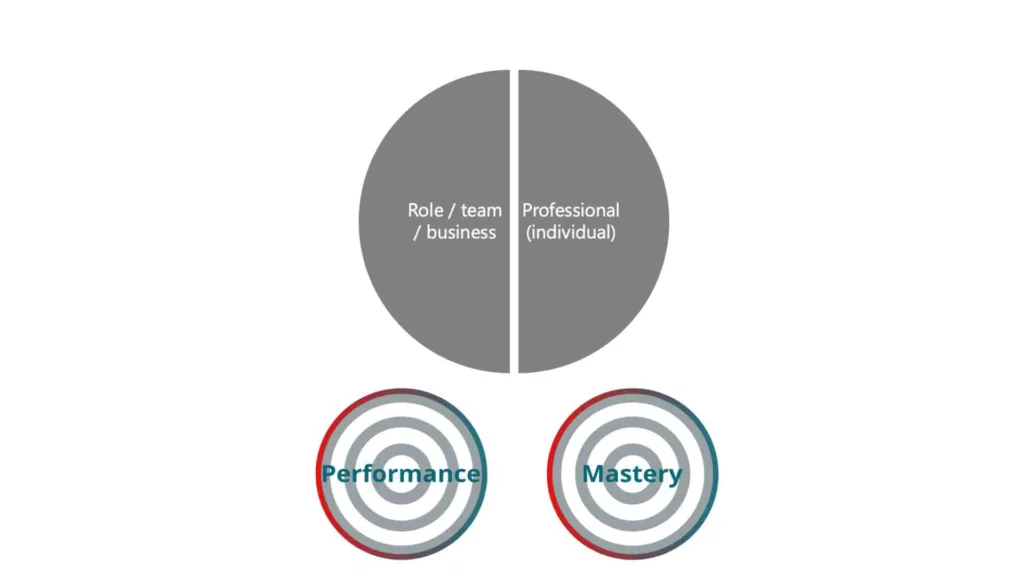
Performance Goals
Performance goals are typically focused on achieving specific outcomes or results. For example, a salesperson might set a performance goal of increasing their sales by a certain percentage over a specific period of time. The emphasis is on achieving a specific outcome, often with a focus on competition and comparison to others.
Mastery Goals
Mastery goals, on the other hand, are focused on developing skills, knowledge, and competence. The focus is on the process of learning and improving, rather than achieving a particular outcome. For example, a student might set a mastery goal of mastering a particular subject or skill, rather than simply getting a good grade.
Differences between Performance Goals and Mastery Goals
The main differences between performance goals and mastery goals are:
1. Focus: Performance goals focus on achieving specific outcomes or results, while mastery goals focus on developing skills and knowledge.
2. Emphasis: Performance goals emphasize competition and comparison to others, while mastery goals emphasize personal growth and improvement.
3. Approach: Performance goals tend to be more outcome-oriented, while mastery goals tend to be more process-oriented.
4. Feedback: Performance goals tend to rely on external feedback (e.g. metrics, rankings), while mastery goals tend to rely on internal feedback (e.g. self-assessment, progress tracking).
Both types of goals can be useful in different contexts. Performance goals can help to motivate individuals to achieve specific outcomes, while mastery goals can foster a love of learning and personal growth. Ultimately, the choice of which type of goal to set depends on the situation, the individual, and the desired outcomes.
Setting the Right Goals for You
How do you know if your goals are what you really want, or what you think you should want?
Have you looked back very new year, or quarter, to see that there are some goals that you never seem to achieve or make progress towards?
Maybe you’ve also worked hard on some goals, but, when you achieve them, you realize that in reality they are not what you want? Stephen Covey, in The 7 Habits of Highly Effective People, calls this “leaning your ladder up the wrong wall.” You sense that some of your goals are not taking you in the right direction for you, or that they inconsistent with your core values.
I’ve certainly done both. In most cases, it’s because I’ve been setting goals based on what I think others expect of me, rather than what I want for myself.
Mirror Neurons
Mirror neurons are a type of brain cell that fire both when we perform an action and when we observe someone else performing the same action. They play an important role in empathy, imitation, and learning. While mirror neurons can be helpful in some contexts, they can also lead us to set goals that aren’t really meaningful to us.
How Mirror Neurons Influence Goal Setting
One way in which mirror neurons can influence goal-setting is through social comparison. When we observe others achieving certain goals, our mirror neurons may fire and we may feel compelled to set similar goals for ourselves. This can lead us to set goals that are not aligned with our own values, interests, or strengths, simply because we think we should be pursuing them.
Another way in which mirror neurons can impact goal-setting is through the influence of others. When we are surrounded by people who have similar goals or values, our mirror neurons can lead us to adopt those same goals or values, even if they don’t feel meaningful to us. For example, if everyone in our social circle is focused on achieving financial success, we may feel pressure to set financial goals for ourselves, even if our true passions lie elsewhere.
Finally, mirror neurons can also lead us to set goals that are not realistic or achievable. When we observe others achieving lofty goals or making rapid progress, our mirror neurons may fire and we may set similarly ambitious goals for ourselves. However, without taking into account our own abilities, resources, and circumstances, we may end up setting goals that are unrealistic or even harmful to our well-being.
Make Sure Your Goals are Meaningful to You
To avoid setting goals that aren’t truly meaningful to you, it’s important to be aware of the influence of mirror neurons and to take a step back to reflect on your own values, interests, and strengths.
Remember that intentional goal setting isn’t just about what you want to achieve. It’s also about what effort and commitment you’re willing to put in.
Be mindful of the influence of others and seek out diverse perspectives and experiences to broaden your horizons.
Set realistic and achievable goals that take into account your own abilities and circumstances, rather than simply mirroring the goals of others.
Make sure that your short-term goals are stepping stones towards your long-term goals.
My book, Idea Time, will take you on a step-by-step creative journey to help you discover the big goals that are meaningful to you, and the skills, connections and steps that will help you to achieve those goals. It’s available here on Amazon. Working through the Idea Time activities is a great first step in your goal setting process.
Set Goals that Build On Your Strengths
Intentional goal setting will enable you to build on your strengths, rather than simply trying to rectify your weaknesses.
It’s a common misconception that we will get the best return on investment from developing weaknesses rather than strengths.
Strengths need nurturing.
Only focusing on weaknesses means that you are not working towards fulfilling your true potential. It takes focus and energy away from growing your strengths. My recommendation is that you consider only working on a weakness if it is getting in the way of one of your core strengths.
Research by Zenger and Folkman shows that 4–5 strengths elevate leaders to the top levels of their organization. Be sure to identify your strengths, and intentionally set goals that support and grow them. There is plenty of evidence that doing so will improve your job satisfaction, well-being, engagement at work, perceptions of stress and collaboration skills.

If you’re not sure about how to identify your strengths, try the Strengthsfinder tool.
Avoid Goal Competition
Intentional goal setting means that you can avoid goal competition.
Goal competition is a phenomenon where two or more goals that we have set for ourselves compete with each other for our time, attention, and resources. This can happen when we have multiple goals that are important to us, but which require different approaches or resources to achieve. Goal competition can make it difficult to achieve our goals because it creates conflict and trade-offs between our competing goals.
Intentional living and goal-setting helps us to get a better balance.
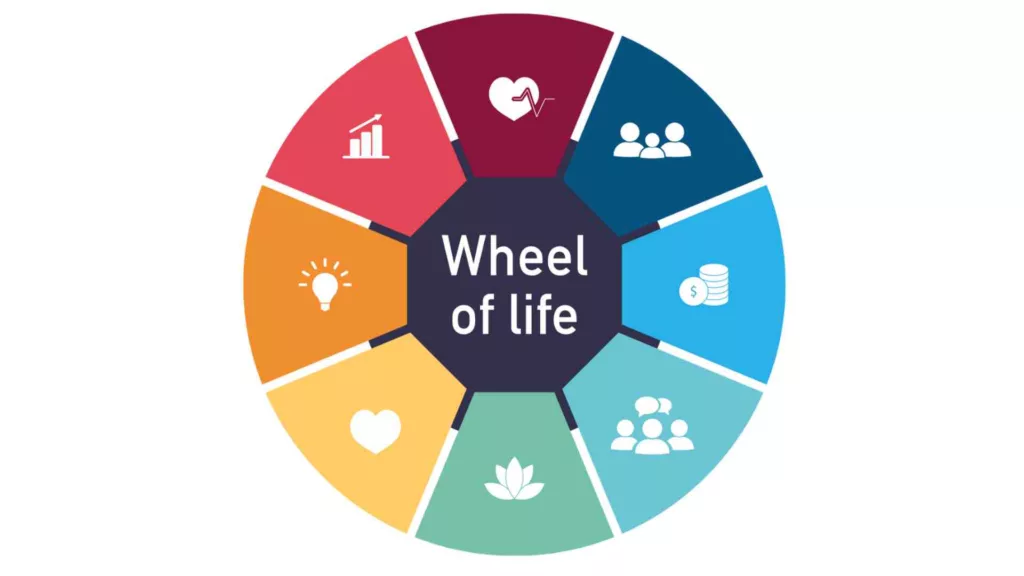
For example, imagine you have two goals: to get in shape and to advance your career. These goals may compete with each other because they require different time commitments and resources. In order to get in shape, you might want to dedicate time to weight-loss through exercise and healthy eating habits. But to advance your career, you may need to work long hours, attend networking events, or take additional courses. These two goals can compete with each other because the time and energy you spend on one may detract from the other.
Be sure to look holistically at everything you have going on in every area of your life as well as work. Take all factors into consideration, and set yourself realistic deadlines for your goals. Include time of year in your planning if some months are much busier or quieter for you than others.
How Goal Competition Prevents Success
Goal competition can stop you from achieving your goals in several ways:
1. Conflicting priorities: When you have competing goals, it can be difficult to prioritize which goal to focus on first. This can lead to a lack of clarity and direction, which can make it difficult to make progress on any of your goals.
2. Resource depletion: When you have competing goals, you may find yourself spread too thin, trying to devote time and energy to all of them at once. This can lead to burnout and exhaustion, making it difficult to make progress on any of your goals.
3. Negative emotions: When you experience conflict between your goals, it can create negative emotions such as stress, frustration, and anxiety. These emotions can be demotivating and make it difficult to stay committed to your goals.
How to Overcome Goal Competition
To overcome goal competition, it’s important to prioritize your goals and identify which ones are most important to you.
You can also try to find ways to integrate your goals and identify areas where they overlap or complement each other.
Finally, you may need to adjust your goals or expectations to ensure that they are realistic and achievable, given your current resources and circumstances. By doing so, you can avoid the negative impact of goal competition and make progress towards achieving your goals. Your action steps will be manageable and clear.
Set Goals in the Goldilocks Zone
The Goldilocks Zone is the principle that goals should be challenging enough to provide motivation and a sense of accomplishment. But they should not so challenging that they become overwhelming or unachievable.
Just like Goldilocks in the fairy tale who found the perfect porridge, bed, and chair – not too hot, not too cold, not too hard, not too soft, etc. We need to find the “just right” level of difficulty for our goals.
If a goal is too easy, we may feel bored or unchallenged. This can lead to a lack of motivation or effort. On the other hand, if a goal is too challenging or unrealistic, we may feel overwhelmed, stressed, or discouraged. This can lead to giving up or feeling like a failure.
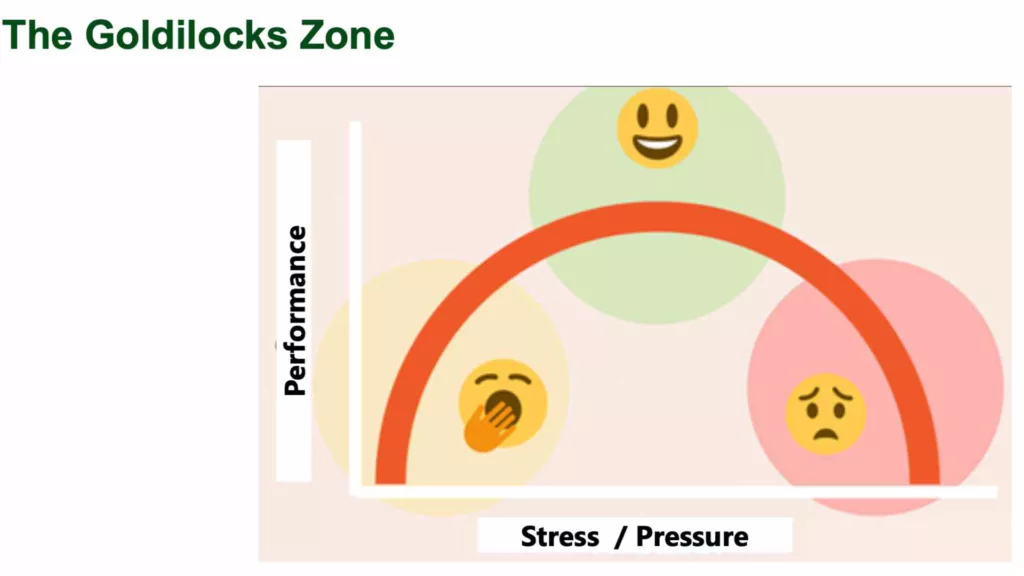
Intentionally Set Goals that Challenge You
The Goldilocks zone for goal setting is different for everyone, depending on their skills, resources, and circumstances.
Some people may thrive on highly challenging goals, while others may prefer more incremental or achievable goals.
A goal that is challenging for one person may be too easy or too hard for another.
To find the Goldilocks zone for a particular goal, it’s important to consider your own abilities, resources, and circumstances.
You can also use feedback and progress tracking to adjust the difficulty level of your goal as you go along. By finding the right balance of challenge and achievability, you can maintain motivation, build confidence, and make steady progress towards achieving your goals.
Intentional Goal Setting for Learning and Growth
Getting from the comfort zone to the learning and growth zones can be a challenging process, but it is essential for personal and professional development.
Here are some steps you can take in your intentional goal setting to move from your comfort zone to the learning and growth zones:
Get Out Of Your Comfort Zone
1. Identify your comfort zone: Start by identifying the areas of your life where you feel most comfortable and secure. These might be activities or situations that you have become accustomed to or where you feel confident and in control. Sometimes they are a little different inside and outside of work.
2. Identify your learning and growth zones: Think about the areas of your life where you would like to learn and grow. These might be activities or situations that you find challenging or intimidating, but which offer opportunities development. Create a clear picture of what you will feel like when you’ve achieved your goals.
3. Set realistic goals: Once you have identified your learning and growth zones, set realistic goals to move towards them. These goals should be challenging but achievable, and should take into account your current abilities and resources.
Experience the Journey
4. Take small steps: It’s important to take small, incremental steps towards your goals, rather than trying to make big changes all at once. This will help you build confidence and momentum, and make it easier to stay motivated. Make solid plans that are realistic and deliverable. Break big tasks into microactions that you can easily add into your daily to-do lists and achieve great things more effortlessly.
5. Embrace discomfort: As you move out of your comfort zone and into your learning and growth zones, it’s natural to feel uncomfortable or anxious. Try to embrace these feelings as opportunities for growth and learning, rather than as signs of failure or weakness. This is often a strength shown by many successful purpose-driven entrepreneurs.
6. Seek feedback: Feedback from others can be a valuable source of information and motivation as you work towards your goals. Seek out constructive feedback from trusted friends, colleagues, or mentors, and use it to adjust your approach and improve your performance. Track your progress to give yourself feedback on how far you’ve come.
Celebrate Progress
7. Celebrate your progress: Finally, it’s important to celebrate your progress and acknowledge your achievements along the way. This will help you stay motivated and build confidence as you continue to move towards your learning and growth zones.
You’ll find my article here on growth mindset, and how to develop the confidence to succeed invaluable.
Hyperclarity and Goals
You’ve considered what you really want, your strengths, priorities, learning and growth areas. The next step is to cultivate hyperclarity for intentional goal setting.
This means being super-clear about who you are, what you want, and how you intend to perform and interact with others in the process.
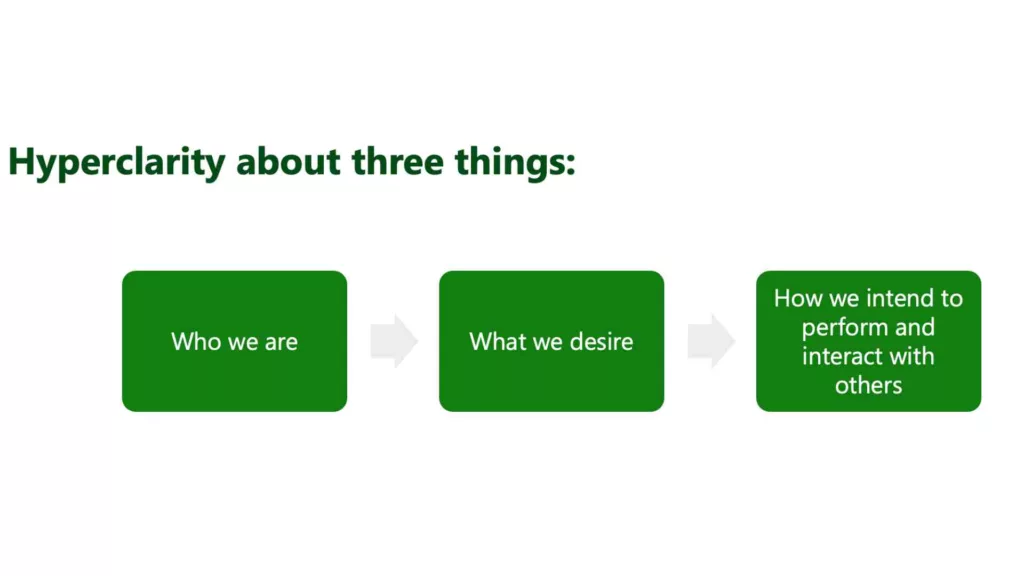
What is Hyperclarity?
Hyperclarity is a state of mind characterized by extreme focus, concentration, and mental clarity. It is a term that is often used in the context of high-performance activities such as athletics, business, or creative endeavors.
Hyperclarity is often associated with a sense of flow or being “in the zone,” where you’re able to perform at your highest level with a heightened sense of awareness and perception. In this state, you minimize distractions, and can concentrate fully on the task at hand, You’ll often experience a sense of timelessness when working on each focus area.
Achieving Hyperclarity for Intentional Goal Setting
You can achieve hyperclarity for intentional goal setting through a variety of methods, such as meditation, visualization, deep breathing, or physical exercise. Also by developing mental skills such as focus, attention, and self-awareness.
Hyperclarity is an important factor in achieving peak performance. It allows you to tap into your full potential and perform at your best. It can also lead to a sense of satisfaction and fulfillment. You’ll achieve your goals and experience a sense of mastery over what you do.
Write Clear Statements for Each of Your Goals
The final step in intentional goal setting is to write clear statements for each of your goals.
Research by Locke shows that, around 90% of the time, setting specific and appropriately challenging goals leads to higher performance than easy, or “do your best,” goals.
It is much more effective to set a goal such as “try to get over 80%” than “try hard”. Or, “concentrate on beating your best time” instead of “try your best”.
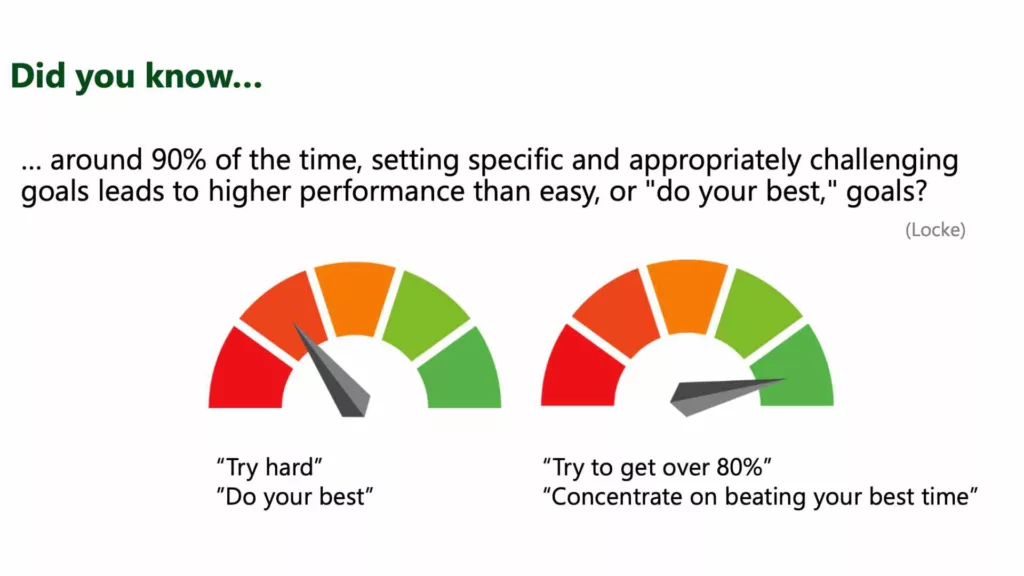
Examples of Goal Statements for Businesses and Teams
Here are a few examples of business or team goal statements.
They can be tailored to fit specific industries, businesses, or individuals.
The key is to ensure that they are specific, measurable, achievable, relevant, and time-bound (SMART).
1. Increase revenue by 20% through targeted marketing campaigns and expanded product offerings.
2. Improve customer satisfaction ratings by 10% through enhanced customer service training and support.
3. Reduce operational costs by 15% through process optimization and automation initiatives.
4. Expand market share by 5% through strategic partnerships and new market entry strategies.
5. Increase employee engagement levels by 15% through improved communication and recognition programs.
6. Enhance brand awareness and reputation through targeted public relations and social media campaigns.
7. Improve product quality and reliability by 20% through enhanced quality control and testing processes.
8. Increase employee productivity by 10% through training and development programs and incentives.
9. Expand global reach by 25% through international expansion and localization strategies.
10. Reduce carbon footprint by 20% through sustainability initiatives and green energy projects.
For a detailed, step-by-step guide on how to facilitate a goal-setting workshop for your team or business, see my article here.
Examples of Professional and Career Goal Statements for Individuals
Here are some examples of professional and career goal statements for individuals:
1. Obtain a professional certification in my field within the next six months to enhance my skills and marketability.
2. Secure a promotion to a managerial position within my current company within the next year to advance my career and increase my salary.
3. Attend at least two industry conferences or events annually to expand my network and stay up-to-date on industry trends and best practices.
4. Develop a personal brand and online presence through blogging, social media, and other channels to increase my visibility and credibility.
5. Pursue a graduate degree in my field within the next two years to deepen my knowledge and expertise and qualify for higher-level roles.
6. Take on a leadership role in a professional organization or industry association to gain valuable experience and expand my network.
7. Develop my soft skills through training or coaching to improve my communication, teamwork, and leadership abilities.
8. Learn a new language or acquire a new skill that is relevant to my field or industry to increase my marketability and versatility.
9. Establish a mentorship relationship with a more experienced professional in my field to gain valuable guidance and advice.
10. Seek out opportunities to give back to my community or industry through volunteering, charity work, or pro bono services to build my reputation and contribute to a greater cause.
These are just a few examples of professional and career goal statements for individuals. They can be tailored to fit specific industries, roles, or personal aspirations. Make sure that they are specific, measurable, achievable, relevant, and time-bound (SMART) to drive progress and success.
Intentional Goal Setting – Towards Action
Intentional goal setting is a process of defining clear, specific, measurable, achievable, relevant, and time-bound (SMART) goals for career and business growth. It involves identifying the desired outcomes, developing a plan to achieve them, and taking action to execute the plan.
Intentional goal setting is important for career and business growth because it helps individuals and organizations focus their efforts and resources on the most important priorities. By setting clear goals and developing a plan to achieve them, individuals and organizations can stay motivated and on track towards achieving their objectives.
To set intentional goals for career and business growth, follow a structured approach that includes the following steps:
1. Identify the desired outcomes: Define what you want to achieve in your career or business, and why it is important to you.
2. Develop an action plan: Create a roadmap with specific next steps to achieve your goals, including specific actions, timelines, and resources required.
3. Take action: Execute your plan and monitor your progress towards your goals.
4. Review and adjust: Regularly review your progress towards your goals, adjust your plan as needed, and celebrate your successes along the way.
By following these steps, you can set intentional goals that are aligned with their values, priorities, and aspirations, and take action to achieve them.
And when you reach the finish line with one goal, to keep growing you’ll want to pause, reflect and then intentionally set fresh goals.
Next Steps – Stay Motivated to Achieve Your Goals
Once you’ve set your goals, the next step is to gain traction and maintain momentum. Now head over to my article that gives you easy, practical, science-backed tips to stay motivated to achieve your goals.

